Week Three – Mesa Verde National Park
Mesa Verde National Park was the reason for our trip to the southwest corner of Colorado. Finally, after snow, and rain, and wind, we rose from bed with a forecast for good weather. Our first stop in any national park is the visitor center.
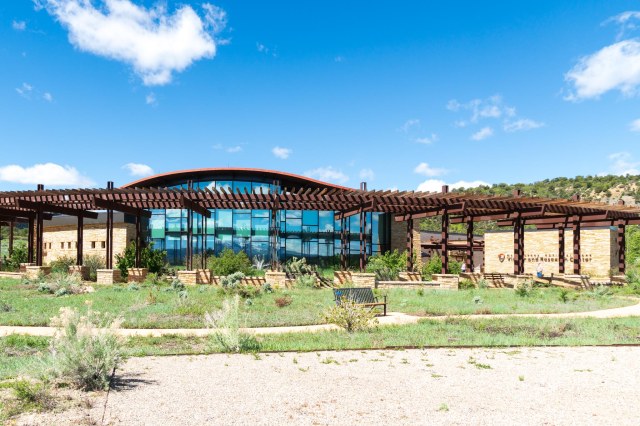
Don’t pass up the visitor center at Mesa Verde. This is the place to purchase tickets for the ranger-guided tours of Cliff Palace and Balcony House on Chapin Mesa and Long House on Wetherill Mesa. These tours provide visitors with an up-close experience that requires short or long hikes, crawling through tunnels, and climbing up ladders. Tours book up fast and may not be available the day of arrival. The $5.00 tickets are available up to two days in advance and can also be purchased at the Durango Welcome Center.
Having tickets in hand before making the one hour drive to the tours will reduce the likelihood of disappointment. Although the roads to the tours are only 23 – 26 miles from the visitor center, it takes about an hour to drive there, even longer if stopping at the various overlooks.
Do not despair, if tickets are sold out. There are plenty of sites to see without the need for tour tickets. Several overlooks offer views of the landscapes, cliff dwellings, and pit house villages. Here is a sampling of those sights.
Center stage in front of the visitor center we encountered a sculpture titled “The Ancient Ones” by Edward J. Fraughton. A man, burdened with a basket of what looks to be corn, navigates a cliff side using hand and toe holes. We couldn’t help but be inspired to explore the park after marveling at the man’s struggle.

Behind the visitor center is a good place to view Point Lookout. Hikers can catch the trail to the top at the Morefield Campground.

The Spruce Tree House near the Chapin Mesa Archeological Museum is the park’s third largest cliff dwelling and was constructed between 1211 and 1278 AD. The dwelling contains 130 rooms, eight kivas, and may have housed at least 60 – 80 people. The self-guided tour of the house was closed due to the risk of falling rock. I walked down the trail a bit to gain a better view for photos only to find that the terrace at the Chapin Mesa Archeological Museum offered the best perspective of the structure. Oh, well. At least I was able to stretch my legs get my heart pumping a bit.
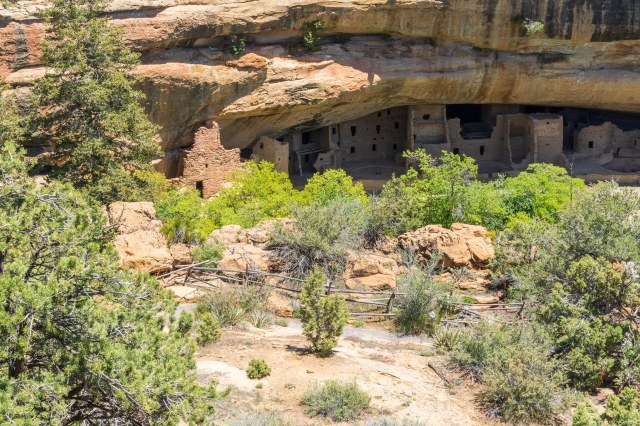
Knife Edge Road carried travelers to Mesa Verde in the early 1900s. The dirt road was eventually paved with asphalt, but abandoned in 1956 when the Morefield-Prater tunnel was constructed.

Fire Temple is one of the few sites that contained no evidence of domestic tasks. It was used as more of a public place possibly for ceremonies that included dancing or other types of performances.
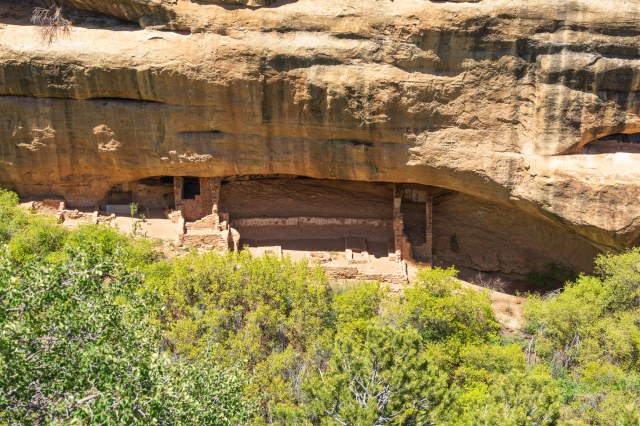
To the right of the public space, is New Fire House, where domestic activity was found in the 22 rooms and 3 kivas. Perhaps the caretakers resided here?

Square Tower House is the tallest structure in the park. The three-story building stands at 28 feet.

Navajo Canyon View

Pit Houses and Villages depict the life of the Ancestral Puebloans who settled in the area around AD 550 and occupied houses built underground. Archeological evidence shows three villages built on top of each other over the course of several hundred years. Around AD 750 people started building houses above ground, using poles and mud to fashion upright walls and utilizing the pit houses as kivas. By AD 1000 stone masonry replaced the poles and mud construction. The thick stone walls rose two to three stories high and consisted of 50 rooms or more. The building of cliff dwellings occurred between the late 1190s to the late 1270s.


To see the Sun Temple requires only a few steps from the parking lot. Archeologists have yet to determine the purpose of the kiva and the tower. Was it for communication, defense, storage, ceremonial, social gatherings, or a religious purpose? Whatever their use, it is clear the buildings were important to the people since they are found everywhere throughout the park and at the other sites we visited.

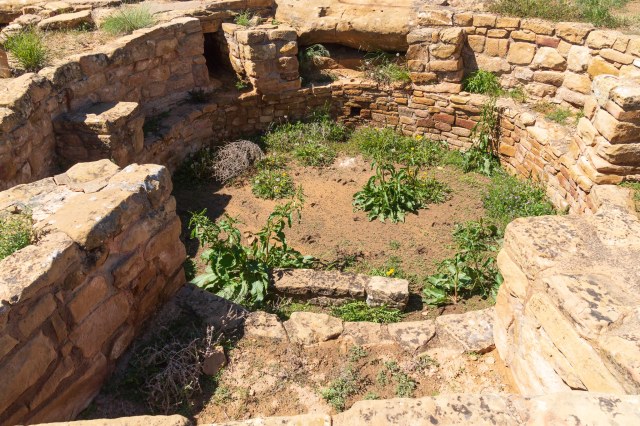
Cliff Palace, the largest dwelling in the park, is viewed from across the canyon. After taking photo after photo at a distance, I had to see it up close, so I booked a tour for another day.

The Cliff Palace overlook provides a good view of the ruin without the ¼-mile walk and climb up four 8- to 10- foot ladders. A ranger-led tour is the only way to view Cliff Palace up close and personal along with 40 other people.
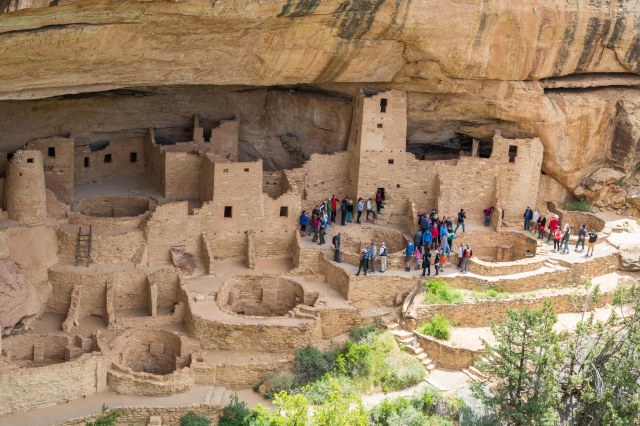
Archeologists have determined Cliff Palace contained at least 150 rooms, 23 kivas, and housed 100 people or more. This compares to the nearly 600 structures within the park, 75% of which only contain 1-5 rooms each. One theory is that the Ancient Puebloans used Cliff Palace for social, administrative, and ceremonial purposes.

Starting in AD 550 people from the Four Corners region arrived at Mesa Verde. Over the next 700 years, they progressed in their architecture until they built the elaborate stone structures in the alcoves of the canyon walls that we see today.

Farming took place above on the mesa tops. Using hand-and-toe holds carved into the soft sandstone, the Ancient Puebloans navigated between the alcoves and the mesa tops.

Imagine carrying tools and supplies for farming up the steep cliffs and toting crops back down using only the hand-and-toe holds, much like the sculpture we saw in front of the visitor center. The ladders were hard enough for me to use with my small backpack on my shoulders and camera strapped around my neck.


Mesa Verde National Park, along with Hovenweep National Monument and Canyon of the Ancients National Monument are very special places to visit. To think that more people lived in the region surrounding Mesa Verde between AD 550 and AD 1250 than live there today strains my brain. Their skills as master potters, weavers, architects, and builders using only basic primitive tools that they manufactured themselves, says so much about the perseverance of mankind.
As I sit at my desk, surrounded by electronics, cool air blowing in the room from the air conditioner, I can’t help but think how small my life is in comparison with the ancient people. They grew their own food, while I drive to the grocery store and push around a cart gathering products from the shelves. They made their own clothes, shoes, pottery, rugs, and blankets, while I head to the mall or order online. They erected elaborate structures that sheltered hundreds of families to keep them safe and warm using only the products in their immediate surroundings. If I want shelter I call a realtor or the closest RV dealer.
I look at how far we have come as a civilization in the past 1500 years and question whether we are truly better off or have we lost something of our humanity along the way. Just something to ponder. I’m in no way wanting to give up my air conditioning when the temperatures rise above 100 degrees. I only want to know what the ancient peoples had that I might be missing, be it sociological, philosophical, psychological, or spiritual.
Okay, all that pondering is bringing on a headache. Time to wrap up here.
Next, we take a drive to Silverton, Colorado, I take photos around Cortez, and we head for home. Jon’s had enough of sciatica. Time for an MRI.
Safe Travels

Thanks for the photos so I could revisit one of my favorite U.S. parks.
LikeLike
You’re welcome. I hope you enjoyed the journey.
LikeLike
I visited Mesa Verde recently and this is a really good photo essay and description of what to expect. It’s so funny that I know exactly where you were standing to take some of these photos … because I took the same shots. There’s certainly a lot to see at Mesa Verde, and as you say, thinking about the harshness of life for the Ancient Puebloans is enlightening. Good post. ~James
LikeLike
Thanks for your comment, James. It’s fun to see posts from other travelers on places we visit. It gives us a different perspective.
LikeLiked by 1 person